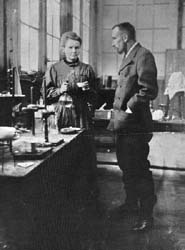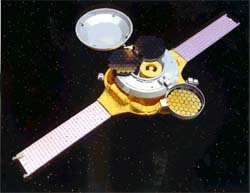A History of Our Understanding of the Sun - A Closer Look
Pre-Twentieth Century Western Knowledge of the Sun
Ancient cultures, such as the Aztecs, the Mayans, the Hebrews, and the Egyptians, made careful observations of the motion of the sun through the sky. Western philosophers and scientists have been intrigued with the sun since the days of Athens and even before. Over recorded history, numerous pronouncements were made about the sun, and up through the 18th century, simple astronomical measurements on the sun were carried out with varying degrees of accuracy.
| |
 |
|
Aztec stone calendar portion
Courtesy: Rene Voorburg |
In the 18th century, remarkable discoveries were being made about Earth itself, most notably about its age. It was then widely accepted that the Earth was 6,000 years old, based on Biblical history as interpreted by Irish scholar Archbishop James Ussher in 1654. However, in the latter part of the 18th and then in the 19th century, scientific estimates began to appear that pushed the age of the Earth up to almost 100,000 years. These estimates began to cause serious concerns about the means by which the Earth was kept warm for such a long period of time. For a while it was assumed that the Earth was formed as a molten ball of rock that was slowly cooling down. But calculations, most notably those by Sir Isaac Newton, showed that even if the Earth were formed as a hot molten ball of iron it would cool to its present temperature in 50,000 to 75,000 years. The question of the source of the Earth's warmth remained a central problem for all of the 19th and part of the 20th centuries.
In the 1800s, the problem was further complicated by the advances of geology coupled with the appearance of Darwin's theory of the origin of species, published in 1859. The geological processes that shaped the Earth and the time required for evolution to have produced life as we know it today required the Earth and sun to be much older than predicted by the models of the solar system in use at that time. New intellectual discoveries were needed in order to solve the puzzle.
Darwin examined differences among finches in the Galapagos Islands before proposing the theory of the origin of varied species from common ancestors in 1859.
A piece of the solution was provided by the development of the science of thermodynamics during the latter half of the 19th century. Of particular importance was the development of the concept of heat and the idea that energy in its various forms could be quantified. With these new ideas in hand some individuals began to wonder about the energy of the sun-where it came from, how long had it been there, and how long it would last. Of paramount importance was the realization that chemical energy in any form was insufficient to keep the sun going for more than several thousand years. The sun was not a cooling hot ball of iron, nor was it a gigantic globe of burning coal. So, if chemistry could not provide an adequate explanation, could the solar physicists provide a better one? It was clear that an energy source was needed that would function for millions and millions of years and provide energy in the form of heat.

Meteor impacting the sun
Courtesy: McREL
|
The energy source that attracted a large following for many years centered on the concept of gravity. Initially it was proposed that the sun could be fueled by meteors falling into it from outer space. This idea was simple and it had great initial appeal. If a meteor was drawn into the sun by the sun's immense gravitational attraction, the kinetic energy (1/2 its mass x its velocity2) of the meteor would be converted to heat when the meteor collided with the sun, heating both the sun and the remains of the meteor. Upon further consideration, however, it was realized that this proposal fell short because there simply were not enough meteors available, nor was there evidence for the consequent sizeable increase in solar mass. Lord Kelvin (William Thomson), a leading researcher and major contributor to the science of thermodynamics, even proposed that the sun was kept hot through consuming whole planets, thus releasing their gravitational energy upon impact with the sun. This proposal also fell short upon closer inspection, and it was concluded fairly quickly that the meteoric idea and its modifications were not the solution to the problem.
| |
 |
|
|
|
Lord Kelvin, for whom the Kelvin temperature scale is named
Courtesy: Univ. of Frankfurt |
|
Nevertheless, the idea that gravitation played a key role in maintaining the sun's energy output was too attractive to be abandoned by many scientists, perhaps because there were no other current ideas that were more reasonable. For example, in 1854 H. von Helmholtz proposed that the sun was gradually contracting and was thus converting gravitational energy into heat. Helmholtz also suggested that the sun was initially divided into small rock-like pieces or even dust-like particles that were spread out in space. These bits of matter fell inward to what is now the sun's position, releasing their huge gravitational energy upon colliding to form a very hot molten ball. Calculations showed that this hot ball would possess enough stored energy to provide no more than 10 million years or so of solar output at current rates. Based on his continued studies of heat flow, the age of the Earth, and the output of a gravitationally energized sun, Kelvin declared in 1897 that the age of the Earth and sun was 24 million years. This figure remained in direct conflict with evolutionary biology and historical geology, both of which implied a much greater age for the Earth and the sun. It is ironic to note that Kelvin, although dogmatic in stating the correctness of his calculations, hinted that new laws of physics might someday resolve the problem. It would be another 30 years before these new laws and phenomena were discovered and applied to the problem of the energy output and the age of the sun
Twentieth Century Developments
The twentieth century was the beginning of the atomic era. At the very end of the 19th century, x-rays were discovered, the Curies discovered radioactivity in uranium minerals, and evidence that atoms can be subdivided was announced.
| |
 |
|
| |
Marie and Pierre Curie
in their laboratory
Courtesy: University of Frankfurt |
|
Alpha particles (helium atoms that had lost both their electrons) were identified, as were beta rays, later shown to be fast moving electrons. It was established that radioactivity results from the transformation of atoms of one type of element into atoms of a different element. It was further learned that elements release energy through radioactivity. In fact, in 1903 a calculation appeared in which it was shown that 3.6 grams/m3 of radium in the sun would provide all of the heat being produced at the solar surface. (Note: Heat from radioactive sources is often used as a power source in modern day spacecraft, such as Cassini.) It should be noted, however, that there is no spectroscopic evidence for the existence of radium on the sun in this quantity.
The discovery of radioactivity led rather quickly to another challenge to Kelvin's estimate of the age of the Earth, since studies of the half-life of uranium in rocks showed that the Earth must be at least a billion years old. By the 1920s it was widely accepted that Kelvin's estimate was simply wrong and that the Earth was a few billion years old. (Current estimates are that the solar system formed around 4.5 billion years ago.)
| |
 |
|
| |
Albert Einstein
Courtesy: ASU/SERP |
|
In 1905 Einstein proposed that energy and mass are equivalent, as expressed through the now-famous equation: E=mc2. It became tantalizingly clear that the atom was the key to an understanding of energy production in the sun and other stars.
| |
|
|
|
Hans Bethe
Courtesy: Univ. of Frankfort |
|
In the 1920s and 1930s, armed with the new physics and knowledge of isotopic masses, physicists including Arthur Eddington, Hans Bethe, Carl von Weizacker, and others, firmly established that the sun's reservoir of energy is sub-atomic in nature, thus setting aside forever Kelvin's contraction theory.
| |
 |
|
| |
Arthur Eddington
Courtesy: Univ. of Frankfurt |
|
This also marks the point at which the current Standard Solar Model began to take shape, a model in which protons collide within the sun's core, fuse together, and ultimately produce helium along with energy in the form of photons of light.
Nevertheless, there remained in the 1920s a significant dilemma for the astrophysicists to solve. The kinetic energy of the particles in the sun at the temperature Eddington calculated based on mass and luminosity considerations was too low for nuclear fusion reactions to occur. The sun at that temperature simply would not be hot enough to accelerate the protons sufficiently for them to overcome the strong electrostatic repulsive forces preventing like charges from approaching each other close enough (10–15 m) to fuse together.
A revolution in understanding was needed. That revolution turned out to be the development of the quantum theory and an understanding of the "weird" physics of subatomic particles.

The wave-particle duality
Courtesy: McREL
|
Two important quantum physics concepts arose in the 1920s that impacted the solar fusion dilemma. First, the so-called strong nuclear force was described, which acts only over extremely short nuclear distances and which, at these distances, could overwhelm the electrostatic repulsive forces between like-charged particles such as protons. Second, in the quantum world of sub-atomic particles such as protons and electrons, wave character was ascribed to particles. Acting as a wave rather than a particle confers a certain amount of mysterious uncertainty, since waves by their very nature are spread out and do not occupy a definite volume in the same way that particles do.
Armed with these two concepts, it became possible to offer a reasonable scenario for nuclear fusion in the sun's core at relatively "low" temperatures. First, if the protons can ever approach one another closely enough, the nuclear strong force will overwhelm the electrostatic repulsive force. Second, if the particles are wavelike in nature, they can "tunnel" into each other, allowing the particles to get close enough together for the nuclear strong force to exert itself. It was soon shown that the energy of the sun might indeed arise from gluing protons together, even though at that juncture the chemical composition of the sun was still extremely uncertain.
It was not until the 1930s that scientists using spectroscopic techniques established beyond a doubt that hydrogen is the most abundant element in the sun. Nevertheless, it should be noted that lack of knowledge about the exact composition of the sun continued to be a roadblock to scientific progress. It was not until the 1950s that astrophysicists were able to say with certainty that proton-proton fusion is of utmost importance in solar energy production.
Contribution of the Genesis Mission
| |
 |
|
| |
Artist's rendering of the Genesis mission spacecraft
Courtesy: LMA |
|
The purpose of the Genesis mission, launched in 2001, is to collect pure samples of solar wind, both bulk and divided by production regime, and return them to Earth in 2003 for analysis. Scientists all over the world will work with portions of the returned sample, which will be stored in specially-constructed cleanroom facilities at the Johnson Space Center in Houston, Texas. They will be particularly interested in establishing the isotopic abundance ratios for the various elements present in the solar wind. The results of the Genesis mission will form a baseline of knowledge about the sun for years to come. |
